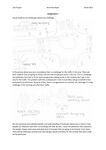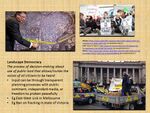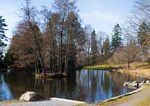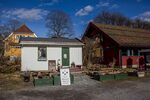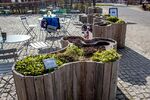LED Online Seminar 2017 - Working Group 4
--> Back to working group overview
Dear working group members. This is your group page and you will be completing the template gradually as we move through the seminar. Good luck and enjoy your collaboration!
Assignment 1 - Reading and Synthesizing Core Terminology
- You can read more details about this assignment here
- Readings are accessible via the resources page
Step 1: Your Landscape Democracy Manifestoes
Step 2: Define your readings
- Please add your readings selection for the terminology exercise before April 12:
A: Landscape and Democracy - Mapping the Terrain
Landscape Concepts:
- Olwig, Kenneth R. (1996): "Recovering the Substantive Nature of Landscape" In: Annals of the Association of American Geographers, 86 (4), pp. 630-653. Cambridge/Oxford: Blackwell Publishers.
- Burckhardt, Lucius (1979): Why is landscape beautiful? in: Fezer/Schmitz (Eds.) Rethinking Man-made Environments (2012)
- Lynch, Kevin. (1960): The Image of the City, Cambridge, Mass.: MIT Press
B: Concepts of Participation
- Gaventa, John: The Powerful, the Powerless, and the Experts
C: Community and Identity
- Francis, Mark: A Case Study Method for Landscape Architecture
D: Designing
- Hester, Randolph: Life, Liberty and the Pursuit of Sustainable Happiness
E: Communicating a Vision
Steps 3 and 4: Concepts Selection and definition
- Each group member selects three relevant concepts derived from his/her readings and synthesize them/publish them on the wiki by April 30, 2017
- Group members reflect within their groups and define their chosen concepts into a shared definition to be posted on the wiki by May 10, 2017.
- Other group members will be able to comment on the definitions until May 20, 2017
Concepts and definitions
Author 1 - Stephen Flack:
- Concept 1
The original Germanic word 'landschaft' incorporated both the meaning of a discrete unit of territory as well as the sense of landscape being a construct of perception through the eyes of humans. Over time it also came to mean the human laws, customs and traditions associated with an area that helped form a specific identity for the people living there. Northern European landscape art represents 'landschaft' as it was intended to emphasise the link between land and the customs and culture of the people depicted. This is opposed to Italianate landscape art, which emphasised timeless universal laws of landscape tracing back to Roman ideals (Olwig 1996).
- Concept 2
A substantive understanding of landscape requires an understanding of the historical and contemporary uses of land and how human development and identity has been shaped by interaction with it (Olwig 1996). This is more 'substantive' than attributing merely 'scenic' value to landscape.
- Concept 3
Case studies in landscape architecture projects allow for approaches to real landscapes in the past to be documented, analysed, critiqued and learnt from. A case study is a comprehensive method of summarising key aspects of a project such as core goals, site analysis, budget, maintenance issues, timeline, decision-making processes and other aspects can be documented (Francis).
References
Francis, Mark: A Case Study Method for Landscape Architecture
Olwig, Kenneth R. (1996): "Recovering the Substantive Nature of Landscape" In: Annals of the Association of American Geographers, 86 (4), pp. 630-653. Cambridge/Oxford: Blackwell Publishers.
Author 2 - Kirsti Henriksen:
- Concept 1
- The Knowledge society is an idea from the Post-industrial society. Post-industrial society is organized around knowledge, for the purpose of social control, and the direction of innovation and change, and this in turn will give rise to new social relationships and new structures which have to be manages politically (Gaventa).
- Concept 2
- The Sustainable city is were ecological science and human needs are prioritized. In order for designers to make this happen, they have to offer different choices and educate people about the concequences of the different choices and help people choose sustainability (Hester).
- Concept 3
- The Knowledge elite consists of experts that are determined by society. Knowledge, in addition to land and industry, becomes a product to be owed as capital. Within that economic structure, the expert, the specialist og knowledge, becomes the power broker, much as the landlord or boss in other political economies (Gaventa).
References
Gaventa, John: The Powerful, the Powerless, and the Experts
Hester, Randolph: Life, Liberty and the Pursuit of Sustainable Happiness
Author 3:
- ......
- .......
- .......
Author 4:
- ......
- .......
- .......
Step 5: Reflection
- Please write, as a group, a 250 words reflection on your discourse and document it here
Step 6: Revised manifestoes
- please look again at your initial manifestoes and update them with any new aspects/prespectives you have taken up during this seminar
- Updatedmanifesto1.jpg
xy's updated manifesto
- Updatedmanifesto2.jpg
xy's updated manifesto
- Updatedmanifesto3.jpg
xy's updated manifesto
- Updatedmanifesto4.jpg
xy's updated manifesto
- Updatedmanifesto5.jpg
xy's updated manifesto
Assignment 2 - Your Landscape Symbols
- You can read more details about this assignment here
Landscape Symbols Author 1
- Symbol yourname photovoice1
add a caption (one paragraph max) description of the symbolism, interpretation, as well as geo-location
- Symbol yourname photovoice2
add a caption (one paragraph max) description of the symbolism, interpretation, as well as geo-location
- Symbol yourname photovoice3
add a caption (one paragraph max) description of the symbolism, interpretation, as well as geo-location
- Symbol yourname photovoice4
add a caption (one paragraph max) description of the symbolism, interpretation, as well as geo-location
- Symbol yourname photovoice5
add a caption (one paragraph max) description of the symbolism, interpretation, as well as geo-location
Landscape Symbols Author 2
- Symbol yourname photovoice1
add a caption (one paragraph max) description of the symbolism, interpretation, as well as geo-location
- Symbol yourname photovoice2
add a caption (one paragraph max) description of the symbolism, interpretation, as well as geo-location
- Symbol yourname photovoice3
add a caption (one paragraph max) description of the symbolism, interpretation, as well as geo-location
- Symbol yourname photovoice4
add a caption (one paragraph max) description of the symbolism, interpretation, as well as geo-location
- Symbol yourname photovoice5
add a caption (one paragraph max) description of the symbolism, interpretation, as well as geo-location
Landscape Symbols - Stephen Flack
Landscape Symbols - Kirsti Henriksen
This is a caption of "Andedammen" at NMBU campus. The red and white doghouse in the middle of the dam symbolizes "Hannkattene", an old fraternity for students at NMBU - Norwegian University of Life Sciences. This dam is a social connecting point for the fraternities and students at the university, providing a great place to connect and meet new people.
Assignment 3 - Role Play on Landscape Democracy "movers and shakers"
- You can read more details about this assignment here
- Samuel Mockbee (The Rural Studio) - Kirsti Henriksen
- Sonja Hörster - Stephen Flack
Assignment 4 - Your Landscape Democracy Challenge
- You can read more details about this assignment here
- Each group member will specify a landscape democracy challenge in his/her environment
Landscape Democracy Challenge 1
- Give a title to your challenge
- Yourname challenge 2.jpg
The ‘10/30 right’ allows property owners to clear any vegetation, including trees, within 10 metres of a house and any vegetation except for trees within 30 metres of a building used for accommodation, without the need for a permit.
- Yourname challenge 3.jpg
The issue is between the right of people to protect their houses from fire risk and a 'one size fits all' clearing rule that results in vegetation being cleared for purposes other than bushfire protection, with loss of biodiversity and landscape character
Your references:
- ...
- ...
Landscape Democracy Challenge 2
- Give a title to your challenge
- Yourname challenge 1.jpg
caption: why did you select this case?
- Yourname challenge 2.jpg
caption: what is the issue/conflict (1)
- Yourname challenge 3.jpg
caption: what is the issue/conflict (2)
- Yourname challenge 4.jpg
caption: who are the actors?
Your references:
- ...
- ...
Landscape Democracy Challenge 3
- Give a title to your challenge
- Yourname challenge 1.jpg
caption: why did you select this case?
- Yourname challenge 2.jpg
caption: what is the issue/conflict (1)
- Yourname challenge 3.jpg
caption: what is the issue/conflict (2)
- Yourname challenge 4.jpg
caption: who are the actors?
Your references:
- ...
- ...
Landscape Democracy Challenge - Kirsti Henriksen
- Give a title to your challenge
- Yourname challenge 1.jpg
caption: why did you select this case?
- Yourname challenge 2.jpg
caption: what is the issue/conflict (1)
- Yourname challenge 3.jpg
caption: what is the issue/conflict (2)
- Yourname challenge 4.jpg
caption: who are the actors?
Your references:
- ...
- ...
Landscape Democracy Challenge 5
- Give a title to your challenge
- Yourname challenge 1.jpg
caption: why did you select this case?
- Yourname challenge 2.jpg
caption: what is the issue/conflict (1)
- Yourname challenge 3.jpg
caption: what is the issue/conflict (2)
- Yourname challenge 4.jpg
caption: who are the actors?
Your references:
- ...
- ...
Assignment 5 - Your Democratic Change Process
- You can read more details about this assignment here
- After documenting and reflecting on your challenges you will continue jointly with one of these challenges and design a democratic change process
Your Democratic Change Process
- Add the title of your project
- Yourgroupname 2017 powermap.jpg
a power map identifying who is affected by the challenge and who is influencing it
- Yourgroupname 2017 change process (1).jpg
Look at the various methods and tools available and think how they can be applied creatively. Think about the needs of different stakeholder groups - you may need a methodical mix to address them all. Illustrate graphically how these methods/tools might be applied in a short, medium and long-term perspective.
- Yourgroupname 2017 scenario.jpg
a scenario illustrating how these tools can be applied within a short, medium and long term perspective involving the groups you want to address, this should include a process timeline
Reflection
- Evaluate in the group how far your ideas either built on the theoretical frame that has been introduced to you during this seminar or react to this by filling a potential gap (approx 150 words)
Your references
- ....
- ....
- ....
- ....


